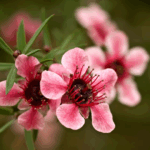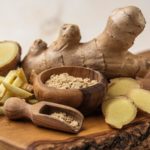
Anagha Rajan
BAMS (Bachelor of Ayurvedic Medicine and Surgery), Master of Health Science, Master of Health and Yoga Therapy
Jump to:
In traditional Ayurvedic medicine, Haritaki is held in high esteem due to its medicinal purposes, and is often added to many formulations.
Modern medicine and studies tell us that Haritaki can assist with:
- Arthritis and joint pain
- Longevity and anti-aging
- Diabetes and blood sugar control
In this article, we will look more into these studies and also review the nutritional benefits of Haritaki as a fruit.
Introduction
Haritaki or Terminalia chebula Retz. (family Combretaceae) is one of the most common herbs used in traditional Ayurvedic medicine.
The Sanskrit name “Haritaki” refers to the yellowish dye or “Haritak” that the fruit contains. It also indicates that the tree resides in the abode of God Shiva, the Himalayas. The other meaning of the word Haritaki indicates it cures (harayet) diseases.
It is also called Abhaya in Sanskrit, which means fearlessness and indicates the power of the medicine against diseases.
Other names

English: Black myrobalan, Chebulic myrobalan, Gallnut.
Sanskrit: Abhaya, Haritaki, Pathya.
Hindi: Harara, Harad.
Tribal: Rol daru, Hara.
Characteristics
T. chebula is a native of Asia, but is also found in Nepal, Sri Lanka, Myanmar, Bangladesh, Egypt, Iran and Turkey as well as in Pakistan and Yunnan, Tibet, Guangdong, and the Guangxi province of China.
T. chebula is a medium to large highly branched deciduous tree with a height of up to 30 meters and girth of up to 1.5 meters. Leaves are 10-30 cm long and are elliptical, with an acute tip and cordate base. The vasculature of the leaves consists of 6-8 pairs of veins.
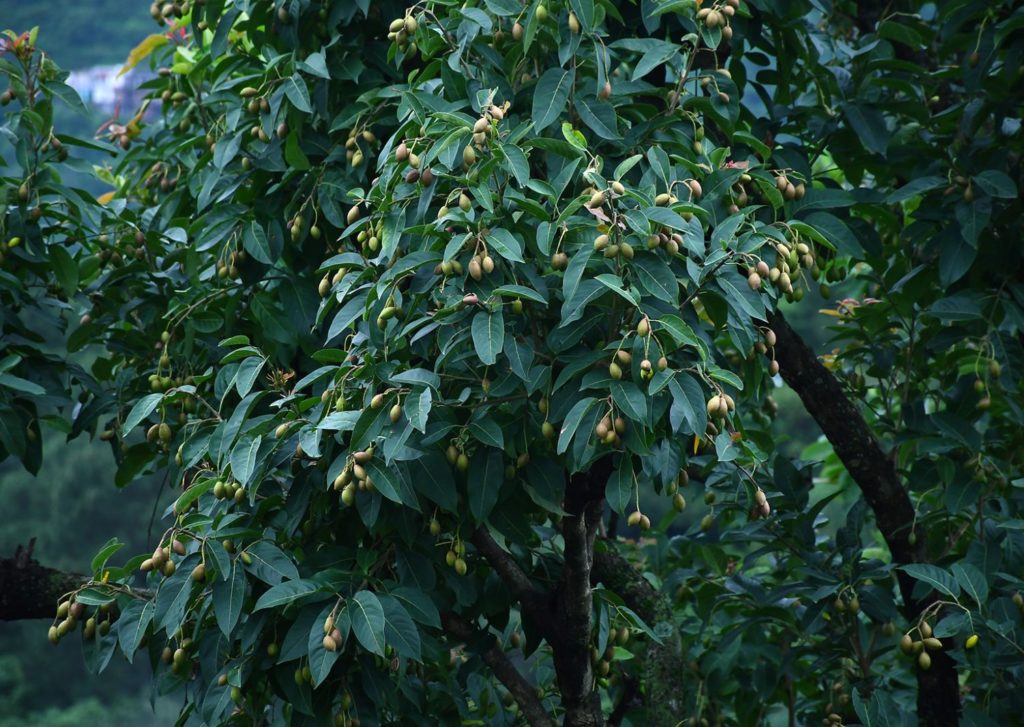
Flowers are short stalked, monoecious, dull white to yellow colour with a strong and unpleasant odour, and are found in simple terminal spikes or short panicles.
The fruit is 3-6 cm long and 1.3-1.5 cm broad, with yellowish-green ovoid drupes containing one oval seed.
T. chebula is capable of growing in a variety of soils, especially in damp as well as shady areas.[1]
Use
Haritaki plays part in different Ayurvedic formulations which can be used in different conditions such as:
- skin diseases
- anaemia
- jaundice
- constipation
- asthma
- piles
- cough
- chronic ulcers
Traditional use
Haritaki is one among Triphala or three fruits, which is a herbal formula consisting of equal parts of three herbs. These are:
- Haritaki (Terminalia chebula)
- Bibhitaki (Terminalia belerica)
- Amalaki (Phyllanthus emblica)
RELATED — Amla (Phyllanthus emblica)
Haritaki is traditionally used in
- skin diseases
- inflammation
- anaemia
- initial stages of liver disease
- haemorrhoids
- anorexia
- cough
- cold
- worm infestation
In Bhavaprakasha Nighantu, which is the Indian Materia Medica, the author mentions ‘Ritu Haritaki’ – for the purpose of Rasayana (rejuvenation, anti-aging and immunity promotion).
Ritu Haritaki is a special practice or regimen where Haritaki is taken with a different Anupana (such as rock salt, sugar, ginger, honey, etc.) in different seasons.
Ritu / Season | How to consume Haritaki |
Monsoon | Haritaki + rock salt |
Autumn | Haritaki + sugar |
Pre- Winter | Haritaki + ginger (Zingiber officinale) |
Winter | Haritaki + long pepper (Piper longum) |
Summer | Haritaki + honey |
Spring | Haritaki + jaggery |
Medicinal use
Chewing the fruits of Haritaki increases “digestive fire”. If it is made into a paste and eaten, it clears and cleanses the bowel.
If Haritaki is taken after food, it eliminates all toxins that enter the body due to food poisoning by cleansing the bowel.
If taken with sugar, Haritaki balances Pitta, and if consumed with ghee, it balances Vata.[2]
RELATED — Vata imbalance: Are you always worried, anxious and cold?
Haritaki also has potent rejuvenating and anti-diabetic properties and it also reduces arthritis.
Nutritional facts
Haritaki is a good source of potassium and calcium, which makes it a great addition to a healthy diet.[3]
RELATED — Calcium (for healthy bones, teeth and heart)
Haritaki nutritional values per 100 g | |
Protein | 3.78 g |
Energy | 6.36 KJ/g |
Carbohydrate | 9.21 g |
Phosphorus | 64.6 mg |
Potassium | 968.2 mg |
Calcium | 128.1 mg |
Magnesium | 67.3 mg |
RELATED — Magnesium (for a great night of sleep)
Health benefits
Antiarthritic activity
A study on rodents examining anti-arthritic properties of Haritaki, showed that Terminalia chebula hydroalcoholic extract (TCHE) produced a significant reduction in joint swelling in arthritis.
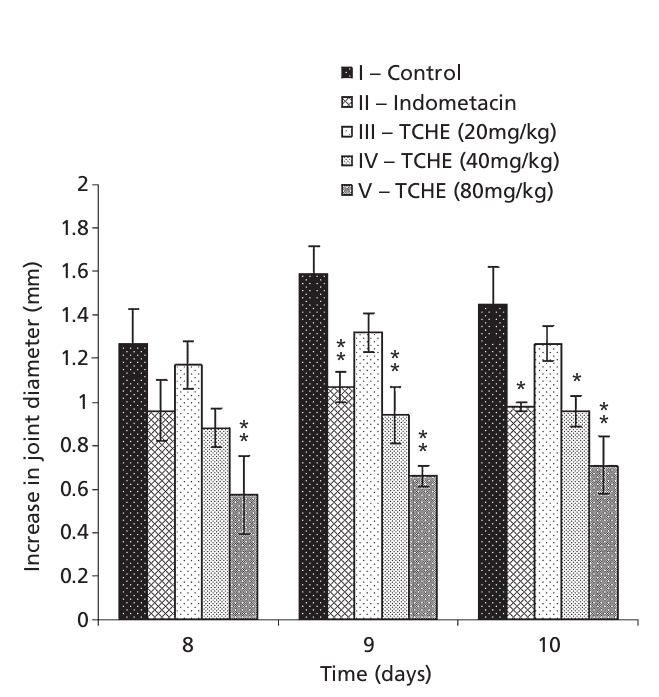
Chronic administration did not make any physiological and pathological changes in the tested subjects. This might suggest the safety of long-term use.[4]
Anticancer activity
A study done in 2016, where Ethanolic Gall Extract of Terminalia chebula was evaluated against
- buffalo rat liver cells
- human mammary gland adenocarcinoma
- human lung cancer cell lines
The study established the anticancer activities of T. chebula leaf gall extracts, whereby it exerted a potent cytotoxic effect on cancerous cells.
This may be due to the rich presence of phytoconstituents such as the phenolics/flavonoids that have been demonstrated to act as cytotoxic agents.
The following table shows IC 50 value of ethanolic leaf gall extract of T. chebula against each cell; where IC 50 value is the measure of the concentration of a drug or compound required to inhibit a particular biological or biochemical process by 50%.[5]
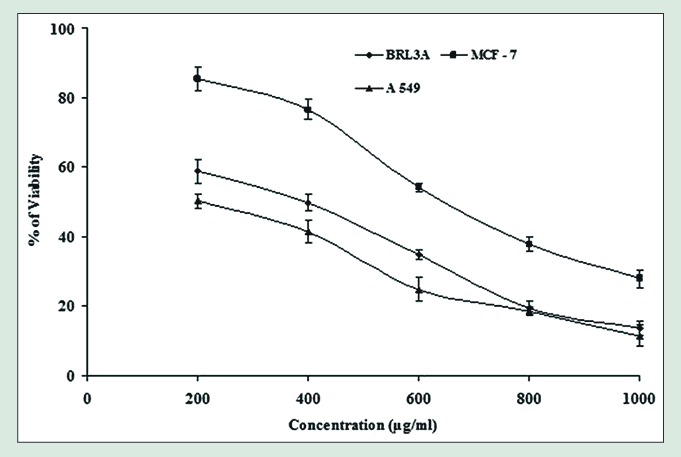
Anti-aging properties
In a study of 15 plants, including Haritaki gall, the results demonstrated potent anti-aging effects of cold aqueous extract of T. chebula gall.[6]
The plants included in this study are,
- Acorus gramineus L. (Araceae)
- Cassia fistula L. (Leguminosae)
- Cyperus rotundus L. (Cyperaceae)
- Dregea volubilis (L.f.) Benth. Ex Hook.f. (Asclepiadaceae)
- Eclipta prostrata L. (Asteraceae)
- Myristica fragrans Houtt. (Myristicaceae)
- Nigella sativa L. (Ranunculaceae)
- Plumbago indica L. (Plumbaginaceae)
- Piper nigrum L. (Piperaceae)
- Pellacalyx parkinsonii Fisch. ST (Rhizophoraceae)
- Piper sarmentosum Roxb. (Piperaceae)
- Plumbago zeylanica L. (Plumbaginaceae)
- Terminalia chebula Retz. (Combretaceae)
- Tinospora crispa L. (Menispermaceae)
- Zingiber officinale Roscoe (Zingiberaceae).
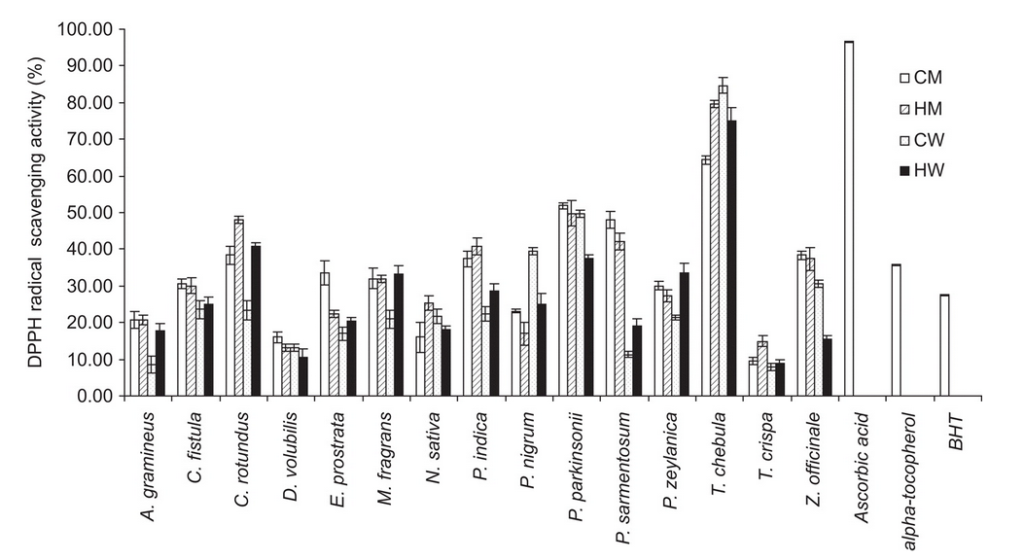
CM, cold methanol process; HM, hot methanol process;
CW, cold aqueous process; HW, hot aqueous process.
The biological activities which are related to aging are
- antioxidative ability
- tyrosinase inhibition
- cell proliferative stimulation
were used to assess the anti-aging properties of each plant. Haritaki showed significant anti-aging characteristics in this study.
Anti-diabetic and anti-hyperglycemic activity
The dried immature fruit of Haritaki displayed a considerable α-glucosidase inhibitory effect. This means that it inhibits absorption of carbohydrates from the small intestine, which helps in controlling type 2 diabetes.
It also stimulates glucose-mediated insulin secretion and intestinal transport of glucose.

Diabetic control rats were compared with control rats; diabetic + T. chebula and diabetic + glibenclamide treated rats were compared with diabetic control rats.
A study of oral administration of ethanolic extract of Haritaki for 30 days showed a significant reduction of blood glucose levels as well as glycosylated haemoglobin(HbA1c) in diabetic rats.[7]
Hepatoprotective activity
A study regarding the effectiveness of Haritaki as a herbal medicine demonstrated potential hepatic oxidative damage prevention.
The study revealed that ChET (Chebulic ellagitannins which are plant-derived polyphenols) were converted into urolithins with the help of gut bacteria in the colon.
The urolithins have high potential to defend the liver cells from oxidative injury.[8]
Therapeutic dosage
Adult dosage is usually between 375 mg to 1.5 g of powdered herb twice a day with warm water or honey.
However, it is best to consult with a trained Ayurvedic practitioner for an individualised prescription.
Safety concerns
Haritaki is not recommended for regular use for people who are suffering from
- fatigue
- weight loss
- dry skin
It is also not recommended during pregnancy and acute fever.[9]
Even though Haritaki is used as a herb to prevent diarrhoea, if consumed in higher doses it may also cause it.
As always, it is best to check with your Ayurvedic Practitioner if you are on any medications and/or with any serious health concerns before taking a formula or powder.
Possible interaction with medications
Haritaki might have an effect on anti-diabetic drugs as it lowers blood sugar levels. Taking Haritaki along with diabetes medications might cause blood sugar to drop too low.
Taking Haritaki along with chlorzoxazone might increase the effects and side effects of chlorzoxazone and omeprazole.
Possible interaction with herbs and supplements
It is generally considered safe to consume Haritaki with other herbs and supplements.
Summary
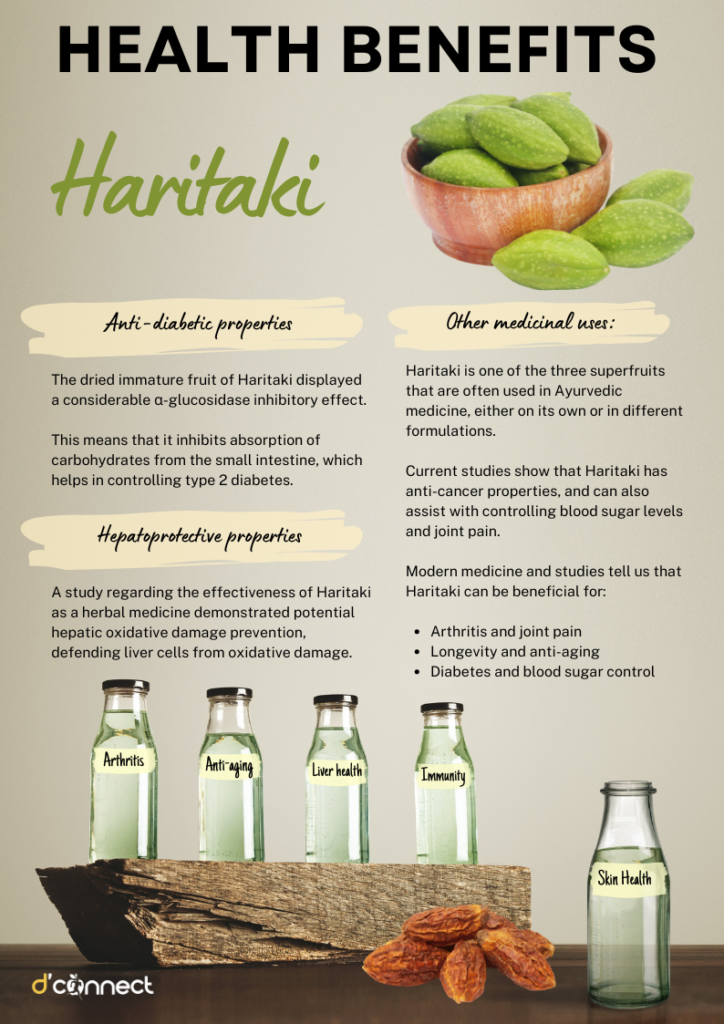
Note — feel free to share or download this illustration.
Related Questions
1. Is it safe to use Haritaki every day?
It is safe to use Haritaki every day if you follow the correct dosage and if it is advised by your health practitioner.
Monitoring its usage and consulting a physician to provide correct dosage and duration is recommended to mitigate any potential risks.
2. Does Haritaki make you sleepy?
Haritaki generally does not induce sleep or drowsiness.
But it is advisable to observe personal reactions to Haritaki before engaging in activities requiring attention and concentration.
3. Can Haritaki help with anxiety?
Haritaki consists of calming properties that may help to reduce anxiety levels and stress.
Haritki can also help to improve mental clarity.
RELATED — Introduction to: Brain Health
References
(1) Hassan Bulbul, M. R., Uddin Chowdhury, M. N., Naima, T. A., Sami, S. A., Imtiaj, M. S., Huda, N., & Uddin, M. G. (2022). A comprehensive review on the diverse pharmacological perspectives of Terminalia chebula Retz. Heliyon, 8(8), e10220. https://www.ncbi.nlm.nih.gov/pmc/articles/PMC9424961/
(2) Dodke, P. C., & Pansare, T. A. (2017). Ayurvedic and modern aspect of Terminalia chebula Retz. Haritaki an overview. International Journal of Ayurvedic and Herbal Medicine, 7(2), 2508-17. https://www.interscience.org.uk/images/article/v7-i2/4ijahm.pdf
(3) Barthakur, N. N., & Arnold, N. P. (1991). Nutritive value of the chebulic myrobalan (Terminalia chebula Retz.) and its potential as a food source. Food chemistry, 40(2), 213-219.
(4) Nair, V., Singh, S., & Gupta, Y. K. (2010). Anti-arthritic and disease modifying activity of Terminalia chebula Retz. in experimental models. Journal of Pharmacy and Pharmacology, 62(12), 1801-1806.
(5) Shankara, B. R., Ramachandra, Y. L., Rajan, S. S., Ganapathy, P. S., Yarla, N. S., Richard, S. A., & Dhananjaya, B. L. (2016). Evaluating the anticancer potential of ethanolic gall extract of Terminalia chebula (Gaertn.) Retz.(combretaceae). Pharmacognosy research, 8(3), 209.
(6) Manosroi, A., Jantrawut, P., Akihisa, T., Manosroi, W., & Manosroi, J. (2010). In vitro anti-aging activities of Terminalia chebula gall extract. Pharmaceutical Biology, 48(4), 469-481. https://www.tandfonline.com/doi/full/10.3109/13880200903586286
(7) Kumar, G. P. S., Arulselvan, P., Kumar, D. S., & Subramanian, S. P. (2006). Anti-diabetic activity of fruits of Terminalia chebula on streptozotocin induced diabetic rats. Journal of health science, 52(3), 283-291.
(8) Olennikov, D. N., Kashchenko, N. I., & Chirikova, N. K. (2015). In vitro bioaccessibility, human gut microbiota metabolites and hepatoprotective potential of chebulic ellagitannins: A case of Padma Hepaten® formulation. Nutrients, 7(10), 8456-8477. https://www.mdpi.com/2072-6643/7/10/5406
(9) Shastry, J. L. N. (2008). Illustrated Dravyaguna Vijnana. Varanasi: Chaukambha Orientalia, 2.


